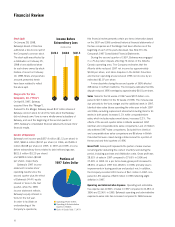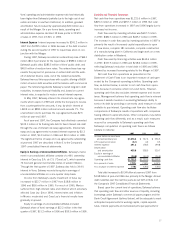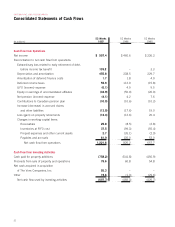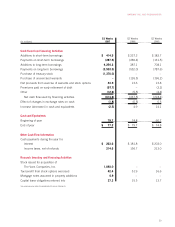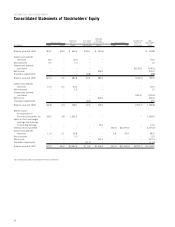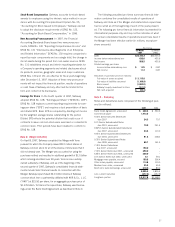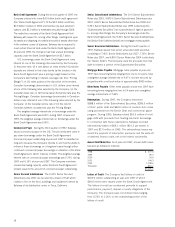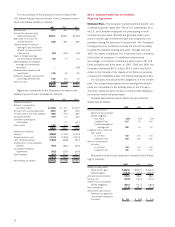Safeway 1997 Annual Report Download - page 28
Download and view the complete annual report
Please find page 28 of the 1997 Safeway annual report below. You can navigate through the pages in the report by either clicking on the pages listed below, or by using the keyword search tool below to find specific information within the annual report.
Note A: The Company and Significant Accounting Policies
The Company Safeway Inc. (“Safeway” or the “Company”) is
the second largest food and drug chain in North America based
on sales, with 1,368 stores, including 315 Vons stores, at year-
end 1997.
The Company’s U.S. retail operating areas are located princi-
pally in Washington, Oregon, northern California, southern
California, Arizona, Colorado and the Mid-Atlantic region. The
Company also has Canadian retail operations which are located
primarily in British Columbia, Alberta and Manitoba/Saskatchewan.
In support of its retail operations, the Company has an exten-
sive network of distribution, manufacturing and food process-
ing facilities.
As discussed in Note B, on April 8, 1997, Safeway acquired
The Vons Companies, Inc. (“Vons”) pursuant to which the
Company issued 83.2 million shares of Safeway common stock
for all of the shares of Vons stock that it did not already own (the
“Merger”). Vons is now a wholly-owned subsidiary of Safeway,
and as of the beginning of the second quarter of 1997, Safeway’s
consolidated financial statements include Vons’ financial results.
In addition to the Safeway and Vons operations, the Company
has a 49% ownership interest in Casa Ley, S.A. de C.V. (“Casa
Ley”), which operates 74 food and general merchandise stores
in western Mexico.
Stock Split In January 1998, Safeway’s Board of Directors
authorized a two-for-one split of the Company’s common stock.
The stock split was effected by a distribution on February 25,
1998 of one additional share for each share owned by stock-
holders of record on February 10, 1998. Share and per-share
amounts presented in the consolidated financial statements
and related notes have been restated to reflect the stock split.
Basis of Consolidation The consolidated financial statements
include Safeway Inc., a Delaware corporation, and all majority-
owned subsidiaries. All significant intercompany transactions and
balances have been eliminated in consolidation. The Company’s
investment in Casa Ley is reported using the equity method.
Prior to the Merger, the Company’s investment in Vons was
reported using the equity method.
Fiscal Year The Company’s fiscal year ends on the Saturday
nearest December 31. The last three fiscal years consist of the
53-week period ended January 3, 1998 and 52-week periods
ended December 28, 1996 and December 30, 1995.
Use of Estimates The preparation of financial statements in
conformity with generally accepted accounting principles
requires management to make estimates and assumptions
that affect the reported amounts of assets and liabilities and
disclosure of contingent assets and liabilities at the date of the
financial statements, and the reported amounts of revenues
and expenses during the reporting period. Actual results
could differ from those estimates.
Translation of Foreign Currencies Assets and liabilities of the
Company’s Canadian subsidiaries and Mexican unconsolidated
affiliate are translated into U.S. dollars at year-end rates of
exchange, and income and expenses are translated at average
rates during the year. Adjustments resulting from translating
financial statements into U.S. dollars are reported as cumulative
translation adjustments and are shown net of applicable income
taxes as a separate component of stockholders’ equity.
Merchandise Inventories Merchandise inventory of $1,118 million
at year-end 1997 and $756 million at year-end 1996 is valued at
the lower of cost on a last-in, first-out (“LIFO”) basis or market
value. Such LIFO inventory had a replacement or current cost of
$1,191 million at year-end 1997 and $835 million at year-end
1996. The remaining inventory is valued at the lower of cost on a
first-in, first-out (“FIFO”) basis or market value. FIFO cost of inven-
tory approximates replacement or current cost. In the United
States, inventory on a FIFO basis includes meat, produce and
inventory of manufacturing operations, except for Vons, which
values all inventory on the LIFO basis. All inventories of the
Canadian subsidiaries are valued on the FIFO basis.
Application of the LIFO method resulted in a decrease in
cost of goods sold of $6.1 million in 1997, and increases of
$4.9 million in 1996 and $9.5 million in 1995. Liquidations
of LIFO layers during the three years reported did not have a
significant effect on the results of operations.
Property and Depreciation Property is stated at cost. Property
acquired in the Merger approximates fair values as of the Merger
date. Depreciation expense on buildings and equipment is com-
puted on the straight-line method using the following lives:
Stores and other buildings 10 - 30 years
Fixtures and equipment 3 - 15 years
Property under capital leases is amortized on a straight-line
basis over the remaining terms of the leases. Leasehold improve-
ments include buildings constructed on leased land and
improvements to leased buildings. Leasehold improvements are
amortized on a straight-line basis over the shorter of the remain-
ing terms of the lease or the estimated useful lives of the assets.
SAFEWAY INC. AND SUBSIDIARIES
Notes to Consolidated Financial Statements
25



